The Holistic Advantage: Unified Quantitative Modeling for Less-Biased, In-Depth Insights into (Socio)Linguistic Variation
Abstract
1. Introduction
2. EngPH Variables under Study
2.1. Past Tense Morphology
2.2. Comparative Marking
2.3. Past Subjunctive and Was/Were
3. Methodology
3.1. Data Source
3.2. Data Pre-Processing and Variable Coding
- Length of utterance (words)
- Quantity of subordinating conjunctions
- Quantity of passives
- Type-to-token ratio
- Presence of stranded preposition
- Noun-to-verb ratio
- Mean length per word (character)
- Quantity of nouns
- Quantity of passives
- Length of utterance (words)
- Quantity of personal pronouns
- Presence of stranded preposition
3.3. Data Analysis
3.3.1. Bayesian Regression Modeling
3.3.2. Boruta Algorithm with Random Forest Modeling
4. Results
4.1. Evaluation of Bayesian Models
4.2. Variation in Past Tense Morphology
- (1)
- Anybody notice the burnt area in SRP across seaside?
- <COPE-TW-CEB-2018-04:198424>
- (2)
- don’t get burned twice by the same flame.
- <COPE-TW-LUC-2016-03:219598>
- (3)
- There’s one key here which I’m scared to say because Manila will get mad at me. You speak English here [Cebu]. And you speak better English here than any other provinces in the country. Romulo, 2006. The Philippine Star.
- (4)
- Why do some people think Visayas people in the Philippines have more knowledge in English than other Philippines areas? Quora.
- (5)
- Why are Cebuanos good in English? Quora.
- (6)
- I’ve heard of that stereotype… Julius from Cebu, 2020, Quora.
- (7)
- Pinas merchant marine is controlled by Cebuanos or Ilonggos. And seamanship requires a working knowledge of English… Raul Montino from Caramines Sur, 2020, Quora.
- (8)
- Also, Tagalog or Pilipino is internal colonization. So most non-Tagalogs would rather set aside Tagalog or Pilipino and go for English. Raul Montino from Caramines Sur, 2020, Quora.
- (9)
- They preferred to struggle in broken English in talking to me than speak Tagalog. They said it was easier to converse with me because most Manilenos insist on Tagalog, which is just as difficult as English to them. But even if they struggled in English, they felt less insulted because of their past bad experience with arrogant Manilenos who imposed Tagalog on them. Josh 2020, Quora.
- (10)
- most Cebuanos avoid using the national language Filipino (Tagalog-derived) as they prefer speaking in their own native Cebuano dialect, or English. Jason from Davao 2019, Quora.
- (11)
- most of the Cebuano and Bisaya aren’t good at Tagalog because of their accent. … they are more comfortable talking in English than Tagalog especially to non-Visayan people because of their accent and English is much easier to converse for them than Tagalog. Jerseld 2023, Quora.
- (12)
- It’s because most Cebuanos in Manila are members of Manila High Society and Spanish Mestizas... A lot of middle class Visayans have migrated to Manila reaching as far as Cavite. They have an upper class … accent and they don’t speak Tagalog. … in Cebu, English is the language of the upper class. And in the past, most Visayans in Manila came from Cebu. Josh 2020, Quora.
- (13)
- Cebuano culture retains a far stronger affinity for … American culture than Tagalog culture, due to various historical reasons, primarily that Cebu was relatively peaceful and stable under…. American administration (as an industrial base, without US military presence), which created far more positive perceptions on … American culture. Thus, we Cebuanos consider … American culture as part of our culture, and we will prefer to speak English, if not in Cebuano… Serena from Cebu, 2020, Quora.
- (14)
- Generally speaking, people in the city [Manila] have better jobs and by extension, more money. Because of this, the person from the city is likely to be richer, statistically speaking… the accent in the city is considered the “neutral” accent, while the rest of the accents are considered “regional”…. Unfortunately for the people who are far from Metro Manila, the Big 4 is concentrated in the capital. Many of the most elite high schools are also in Metro Manila… Because of this, someone who is at the very top of the social pyramid is more likely to be from Metro Manila. Steven, 2016, Quora.
4.3. Variation in the Comparison of Adjectives
- (15)
- The “Visayans” of Central Philippines are considered to be more “jolly, straightforward, jokesters, outgoing, talkative and generally friendly towards strangers... However this is not considered to be “normal” in Luzon… and the further north you go, the more “conservative, silent, aloof and serious” people tend to be... We in Metro Manila may not be as “jolly” as the Visayans, but we are also not as “uptight” as those in the far north … Dayang, 2020, Quora
- (16)
- Southern ethnic groups such as Visayans are more pleasant. They’re friendly, creative, and easy to be with.. Warays are laid-back (but can be fierce at times). Northern ethnic groups, on the other hand, are more conservative. Ilocanos are spendthrifts and hardworking. Kapampangans are very fashion and food conscious and resent losing face much more than other Filipino ethnic groups. Tagalogs are viewed by others as being overly concerned with speed, rude, and standoffish (probably connected with their area being the seat of the capital). Bicolanos are natural stoics. Igorots are proud of their culture and won’t easily give way to an outsider. David, 2022, Quora
- (17)
- most people in Manila can speak English… since Manila is the economic capital, many international economic transactions are done here. Most of the airline personnel, bank tellers, entrepreneurs, hotel staff, government employees, office workers, salespeople and students can speak in fluent English, while blue collar workers and the lower classes can still speak decent English, enough to be understood by a native speaker. Currently, Manila ranked second on the most sought after cities for BPO companies according to Tholons International. Thanks to the fluency of Manileños in English. Allan, 2019, Cavite, Quora
- (18)
- So we’ll just let it simmer for a minute or a minute-and-a-half tapos [‘then’] we ’ll add in our uh one-fourth bar of melt cheese to make it more creamier okay
- <ICE-PHI:S2A-055#98:3:A>
- (19)
- It’s more cheaper … that’s a reality I’m not joking
- <ICE-PHI:S1A-022#111:1:A>
4.4. Variation in the Past Subjunctive
- (20)
- If i was u, i wanna be me…, too
- <COPE-TW-BAC-2017-07:163023>
- (21)
- if I were you, I’d be offended din talaga hahaha…
- <COPE-TW-TUG-2016-06:141853>
5. General Discussion
- The use of -t and -ed past tense morphology (e.g., burnt vs. burned).
- The use of single or double comparison marking (e.g., happier vs. more happier).
- The selection of was or were in past subjunctives with singular subjects (e.g., If I was/were happy)
6. Conclusions
Funding
Institutional Review Board Statement
Informed Consent Statement
Data Availability Statement
Conflicts of Interest
| 1 | Here I define PhE as a group of English dialects that emerged from the interaction between American English and historically indigenous Philippine languages such as Tagalog (Gonzales 2017, 2022a; Thompson 2003). |
| 2 | Kappa = 0.5766, sensitivity = 0.95, specificity = 0.6137, pos pred value = 0.9559, neg pred value = 0.6257, prevalence = 0.89, detection rate = 0.859, detection prevalence = 0.8993, balanced accuracy = 0.773. |
| 3 | Kappa = 0.0436, sensitivity = 0.75, specificity = 0.76, pos pred value = 0.99, neg pred value = 0.03, prevalence = 0.98, detection rate = 0.73, detection prevalence = 0.74, balanced accuracy = 0.70. |
| 4 | Kappa = 0.398, sensitivity = 0.704, specificity = 0.71, pos pred value = 0.80, neg pred value = 0.59, prevalence = 0.625, detection rate = 0.44, detection prevalence = 0.55, balanced accuracy = 0.70. |
References
- Baayen, Rolf Harald. 2008. Analyzing Linguistic Data: A Practical Introduction to Statistics Using R. Cambridge: Cambridge University Press. [Google Scholar]
- Bautista, Maria Lourdes S. 2000. Defining Standard Philippine English: Its Status and Grammatical Features. Manila: De La Salle University Press. [Google Scholar]
- Bell, Allan. 1984. Language Style as Audience Design. Language in Society 13: 145–204. [Google Scholar] [CrossRef]
- Bell, Allan. 2002. Back in style: Reworking audience design. In Style and Sociolinguistic Variation, 1st ed. Edited by Penelope Eckert and John R. Rickford. Cambridge: Cambridge University Press, pp. 139–69. [Google Scholar] [CrossRef]
- Birondo, Cristina. 2006. “Better English” of Cebuanos seen as edge in outsourcing. Philippine Star. Available online: https://www.philstar.com/cebu-news/2006/08/12/352344/better-english-cebuanos-seen-edge-outsourcing (accessed on 15 January 2024).
- Bohmann, Axel. 2016. Language change because Twitter? Factors motivating innovative uses of because across the English-speaking Twittersphere. In English in Computer-Mediated Communication. Edited by L. Squires. Berlin: De Gruyter, pp. 149–78. [Google Scholar] [CrossRef]
- Bohmann, Axel, and Adesoji Babalola. 2023. Verbal past inflection in Nigerian English: A case for sociolinguistic compound vision. In Varieties of English Around the World. Edited by Guyanne Wilson and Michael Westphal. Amsterdam: John Benjamins Publishing Company, vol. G68, pp. 16–41. [Google Scholar] [CrossRef]
- Borlongan, Ariane Macalinga. 2011. Some aspects of the morphosyntax of Philippine English. In Studies of Philippine English: Exploring the Philippine component of the International Corpus of English. Edited by Ma. L. S. Bautista. Mandaluyong: Anvil Publishing, pp. 187–200. [Google Scholar]
- Borlongan, Ariane Macalinga. 2016. Relocating Philippine English in Schneider’s dynamic model. Asian Englishes 18: 232–41. [Google Scholar] [CrossRef]
- Borlongan, Ariane Macalinga, and Shirley Navarro Dita. 2015. Taking a look at expanded predicates in Philippine English across time. Asian Englishes 17: 240–47. [Google Scholar] [CrossRef]
- Bürkner, Paul-Christian. 2017. brms: An R Package for Bayesian Multilevel Models Using Stan. Journal of Statistical Software 80: 1–28. [Google Scholar] [CrossRef]
- Bybee, Joan L. 2006. From Usage to Grammar: The Mind’s Response to Repetition. Language 82: 711–33. [Google Scholar] [CrossRef]
- Collins, Peter, Ariane Macalinga Borlongan, Joo-Hyuk Lim, and Xinyue Yao. 2014. The subjunctive mood in Philippine English: A diachronic analysis. In Studies in Language Companion Series. Edited by Imone E. Pfenninger, Olga Timofeeva, Anne-Christine Gardner, Alpo Honkapohja, Marianne Hundt and Daniel Schreier. Amsterdam: John Benjamins Publishing Company, vol. 159, pp. 259–80. [Google Scholar] [CrossRef]
- Dita, Shirley Navarro, Philip Rentillo, and Aldrin P. Lee. 2022. Grammar. In Philippine English: Development, Structure, and Sociology of English in the Philippines, 1st ed. Edited by Ariane Macalinga Borlongan. London: Routledge, pp. 87–99. [Google Scholar] [CrossRef]
- Dong, Jie. 2009. ‘Isn’t it enough to be a Chinese speaker’: Language ideology and migrant identity construction in a public primary school in Beijing. Language & Communication 29: 115–26. [Google Scholar] [CrossRef]
- Eckert, Penelope. 1999. Language Variation as Social Practice: The Linguistic Construction of Identity in Belten High. Hoboken: Wiley-Blackwell. [Google Scholar]
- Eckert, Penelope. 2012. Three waves of variation study: The emergence of meaning in the study of sociolinguistic variation. Annual Review of Anthropology 41: 87–100. [Google Scholar] [CrossRef]
- Franke, Michael, and Timo Benjamin Roettger. 2019. Bayesian regression modeling (for factorial designs): A tutorial. Preprint. [Google Scholar] [CrossRef]
- Gonzales, Wilkinson Daniel Wong. 2017. Philippine Englishes. Asian Englishes 19: 79–95. [Google Scholar] [CrossRef]
- Gonzales, Wilkinson Daniel Wong. 2021. Filipino, Chinese, neither, or both? The Lannang identity and its relationship with language. Language & Communication 77: 5–16. [Google Scholar]
- Gonzales, Wilkinson Daniel Wong. 2022a. Hybridization. In Philippine English: Development, Structure, and Sociology of English in the Philippines. Edited by Ariane Macalinga Borlongan. London: Routledge, pp. 170–83. [Google Scholar]
- Gonzales, Wilkinson Daniel Wong. 2022b. “Truly a Language of Our Own” A Corpus-Based, Experimental, and Variationist Account of Lánnang-uè in Manila. Ph.D. dissertation, University of Michigan, Ann Arbor, MI, USA. [Google Scholar]
- Gonzales, Wilkinson Daniel Wong. 2023a. Broadening horizons in the diachronic and sociolinguistic study of Philippine English with the Twitter Corpus of Philippine Englishes (TCOPE). English World-Wide. A Journal of Varieties of English 44: 403–34. [Google Scholar] [CrossRef]
- Gonzales, Wilkinson Daniel Wong. 2023b. Spread, stability, and sociolinguistic variation in multilingual practices: The case of Lánnang-uè. International Journal of Multilingualism. [Google Scholar] [CrossRef]
- Gonzales, Wilkinson Daniel Wong. 2023c. Variability in clusters and continuums: The sociolinguistic situation of the Manila Lannangs in the 2010s. Asia-Pacific Language Variation 9: 83–124. [Google Scholar] [CrossRef]
- Gonzales, Wilkinson Daniel Wong. 2024. Sociolinguistic Analysis with Missing Metadata? Leveraging Linguistic and Semiotic Resources Through Deep Learning to Investigate English Variation and Change on Twitter. Applied Linguistics amad086. [Google Scholar] [CrossRef]
- Gonzales, Wilkinson Daniel Wong, and Mie Hiramoto. 2020. Two Englishes diverged in the Philippines? A substratist account of Manila Chinese English: A substratist account of Manila Chinese English. Journal of Pidgin and Creole Languages 35: 125–59. [Google Scholar] [CrossRef]
- González-Díaz, Victorina. 2004. Adjective comparison in Renaissance English. SEDERI 13: 87–100. [Google Scholar]
- González-Díaz, Victorina. 2005. On The Nature and Distribution of English Double Periphrastic Comparison. The Review of English Studies 57: 623–64. [Google Scholar] [CrossRef]
- Grafmiller, Jason, Benedikt Szmrecsanyi, and Lars Hinrichs. 2018. Restricting the restrictive relativizer. Corpus Linguistics and Linguistic Theory 14: 309–55. [Google Scholar] [CrossRef]
- Hansen Edwards, Jette G. 2018. TH variation in Hong Kong English. English Language and Linguistics 23: 439–68. [Google Scholar] [CrossRef]
- Hernandez, Hjalmar Punla. 2023. Does Philippine English subject–verb agreement exist in academic writing? The case of research articles across disciplines. Asian Englishes, 1–18. [Google Scholar] [CrossRef]
- Hundt, Marianne. 2001. Grammatical variation in national varieties of English—The corpus-based approach. Revue Belge de Philologie et d’histoire 79: 737–56. [Google Scholar] [CrossRef]
- Irvine, Judith T., and Susan Gal. 2000. Language ideology and linguistic differentiation. In Regimes of Language. Edited by Paul Kroskrity. Santa Fe: School of American Research Press, pp. 35–83. [Google Scholar]
- Kachru, B. B. 1990. World Englishes and applied linguistics. World Englishes 9: 3–20. [Google Scholar] [CrossRef]
- Kastronic, Laura, and Shana Poplack. 2021. Be that as it may: The Unremarkable Trajectory of the English Subjunctive in North American Speech. Language Variation and Change 33: 107–34. [Google Scholar] [CrossRef]
- Kursa, Miron B., and Witold R. Rudnicki. 2010. Feature selection with the Boruta package. Journal of Statistical Software 36: 1–13. [Google Scholar] [CrossRef]
- Labov, William. 1972. Sociolinguistic Patterns. Philadelphia: University of Pennsylvania Press. [Google Scholar]
- Lee, Aldrin P., and Ariane Macalinga Borlongan. 2022. Internal Variation. In Philippine English: Development, Structure, and Sociology of English in the Philippines, 1st ed. Edited by Ariane Macalinga Borlongan. London: Routledge, pp. 125–34. [Google Scholar] [CrossRef]
- Levin, Magnus. 2009. The formation of the preterite and the past participle. In One Language, Two Grammars? 1st ed. Edited by Günter Rohdenburg and Julia Schlüter. Cambridge: Cambridge University Press, pp. 60–85. [Google Scholar] [CrossRef]
- Levshina, Natalia. 2016. When variables align: A Bayesian multinomial mixed-effects model of English permissive constructions. Cognitive Linguistics 27: 235–68. [Google Scholar] [CrossRef]
- Lê, Sébastien, Julie Josse, and François Husson. 2008. FactoMineR: An R Package for Multivariate Analysis. Journal of Statistical Software 25: 1–8. [Google Scholar] [CrossRef]
- Llamzon, Teodoro. 1969. Standard Filipino English. Quezon City: Ateneo University Press. [Google Scholar]
- MacKenzie, Laurel. 2020. Comparing Constraints on Contraction Using Bayesian Regression Modeling. Frontiers in Artificial Intelligence 3: 58. [Google Scholar] [CrossRef] [PubMed]
- Makowski, Dominique, Mattan S. Ben-Shachar, S. H. Annabel Chen, and Daniel Lüdecke. 2019. Indices of Effect Existence and Significance in the Bayesian Framework. Frontiers in Psychology 10: 2767. [Google Scholar] [CrossRef]
- McElreath, Richard. 2020. Statistical Rethinking: A Bayesian Course with Examples in R and Stan, 2nd ed. Boca Raton: Taylor and Francis, CRC Press. [Google Scholar]
- McKaughan, Howard P. 1993. Toward a standard Philippine English. Philippine Journal of Linguistics 24: 41–55. [Google Scholar]
- Milroy, James, and Lesley Milroy. 1985. Linguistic Change, social network and speaker innovation. Journal of Linguistics 21: 339–84. [Google Scholar] [CrossRef]
- Peters, Pam, Adam Smith, and Minna Korhonen. 2022. Epicentral effects on -ed/-t inflectional variation in Australasian Englishes 1850–2020. World Englishes 41: 446–61. [Google Scholar] [CrossRef]
- Quirk, R., S. Greenbaum, G. Leech, and J. Svartvik. 1985. A Comprehensive Grammar of the English Language. Harlow: Longman. [Google Scholar]
- R Core Team. 2015. R: A Language and Environment for Statistical Computing; Vienna: R Foundation for Statistical Computing. Available online: http://www.R-project.org (accessed on 15 January 2023).
- Samejon, Kevin. 2022. Acoustic and Social Dimensions of Word-Final /z/ Production: Data from Acrolectal Speakers of Philippine English. Paper presented at the 7th International Conference on English Pronunciation: Issues & Practices (EPIP7), Grenoble-Alpes, France, May 18–20; Available online: https://epip7.sciencesconf.org/data/pages/EPIP7_Abstracts_Booklet_May13.pdf (accessed on 1 September 2023).
- Säily, Tanja, Victorina González-Díaz, and Jukka Suomela. 2018. Variation in the productivity of adjective comparison in Present-Day English. In Corpus Approaches to Contemporary British Speech: Sociolinguistic Studies of the Spoken BNC2014. Edited by Vaclav Brezina, Robbie Love and Karin Aijmer. London: Routledge. [Google Scholar]
- Schneider, Edgar. 2003. The dynamics of new Englishes: From identity construction to dialect birth. Language 79: 233–81. [Google Scholar] [CrossRef]
- Seuren, Pieter. A. M. 1973. The comparative. In Generative Grammar in Europe. Edited by F. Kiefer and N. Ruwet. Dordrecht: D. Reidel, pp. 528–64. [Google Scholar]
- Skevis, Aristeidis. 2014. A Historical Outline of the Subjunctive Mood in English: With Special Reference to the Mandative Subjunctive. Master’s thesis, University of Oslo, Oslo, Norway. [Google Scholar]
- Tagliamonte, Sali. 1998. Was/were variation across the generations: View from the city of York. Language Variation and Change 10: 153–91. [Google Scholar] [CrossRef]
- Tagliamonte, Sali, and Rolf Harald Baayen. 2012. Models, forests, and trees of York English: Was/were variation as a case study for statistical practice. Language Variation and Change 24: 135–78. [Google Scholar] [CrossRef]
- Thompson, Roger Mark. 2003. Filipino English and Taglish: Language Switching from Multiple Perspectives. New York: Benjamins. [Google Scholar]
- Vasishth, Shravan, and Bruno Nicenboim. 2016. Statistical Methods for Linguistic Research: Foundational Ideas—Part I: Statistical Methods for Linguistics—Part I. Language and Linguistics Compass 10: 349–69. [Google Scholar] [CrossRef]
- Vaughan, Jill, and Jean Mulder. 2014. The Survival of the Subjunctive in Australian English: Ossification, Indexicality and Stance. Australian Journal of Linguistics 34: 486–505. [Google Scholar] [CrossRef]
- Vehtari, Aki, Andrew Gelman, D. Simpson, Bob Carpenter, and Paul-Christian Bürkner. 2021. Rank-Normalization, Folding, and Localization: An Improved Rˆ for Assessing Convergence of MCMC (with Discussion). Bayesian Analysis 16: 667–718. [Google Scholar] [CrossRef]
- Waller, Tim. 2017. The subjunctive in Present-Day English: A Critical Analysis of Recent Research, Leading to a New Diachronic Investigation of the Mandative Subjunctive. Ph.D. dissertation, University College London, London, UK. [Google Scholar]
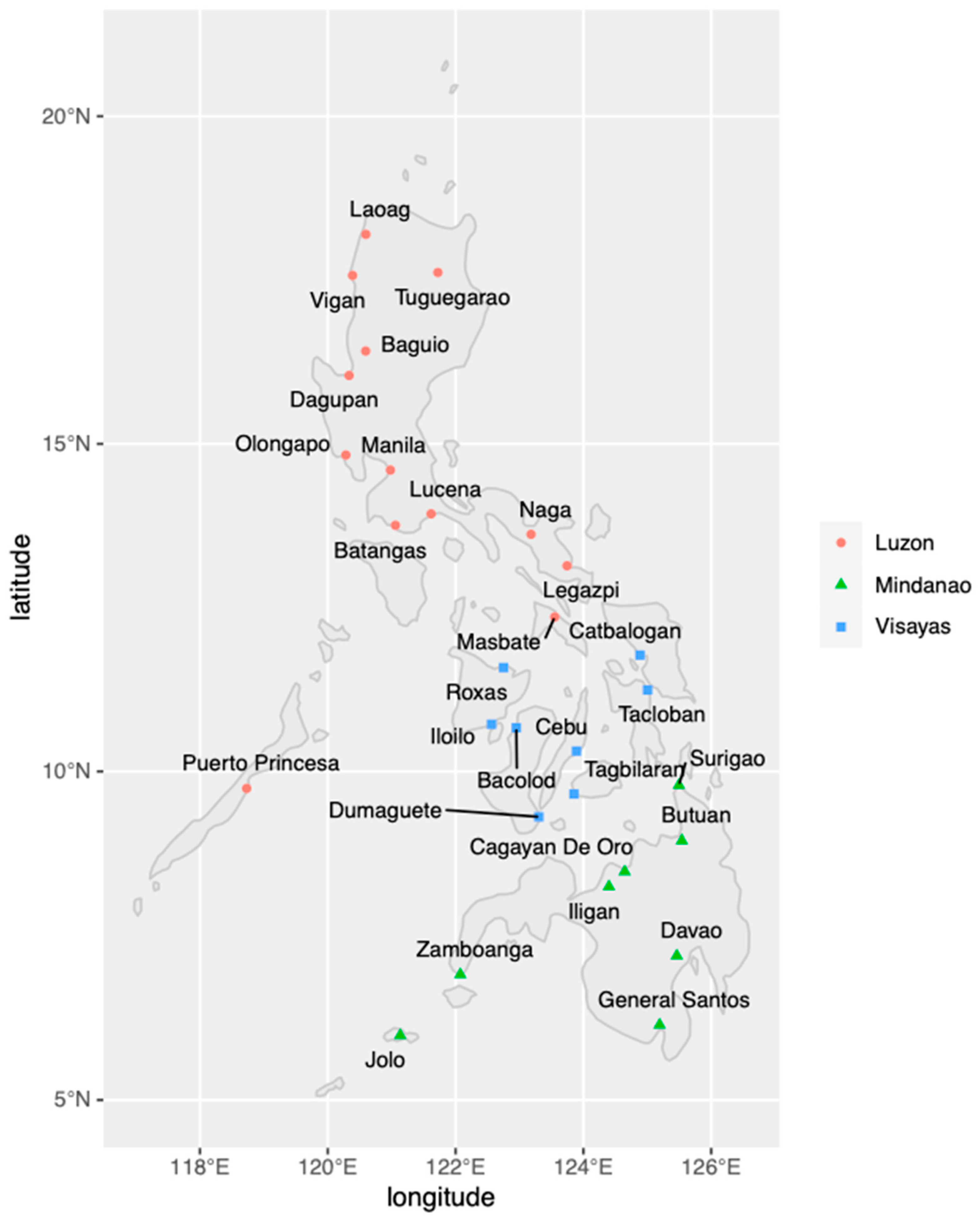


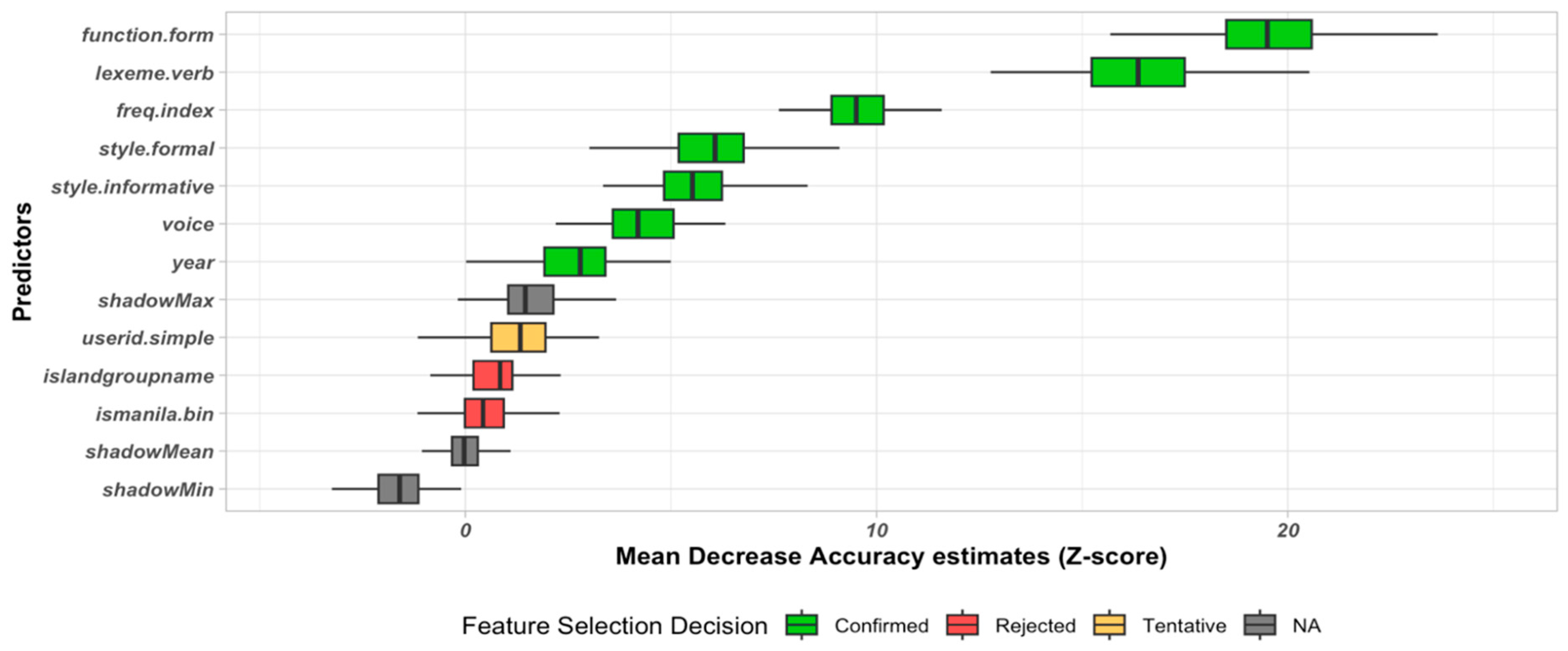
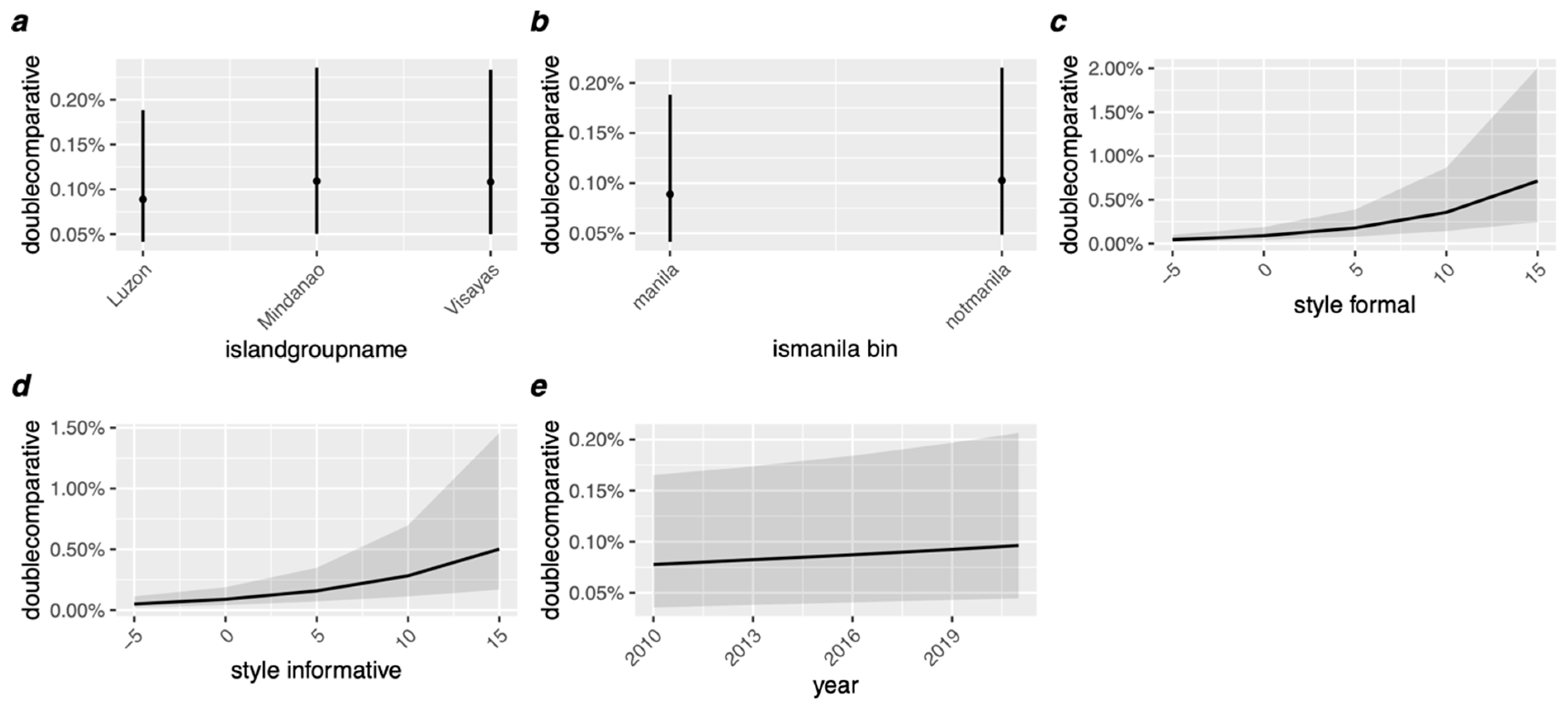
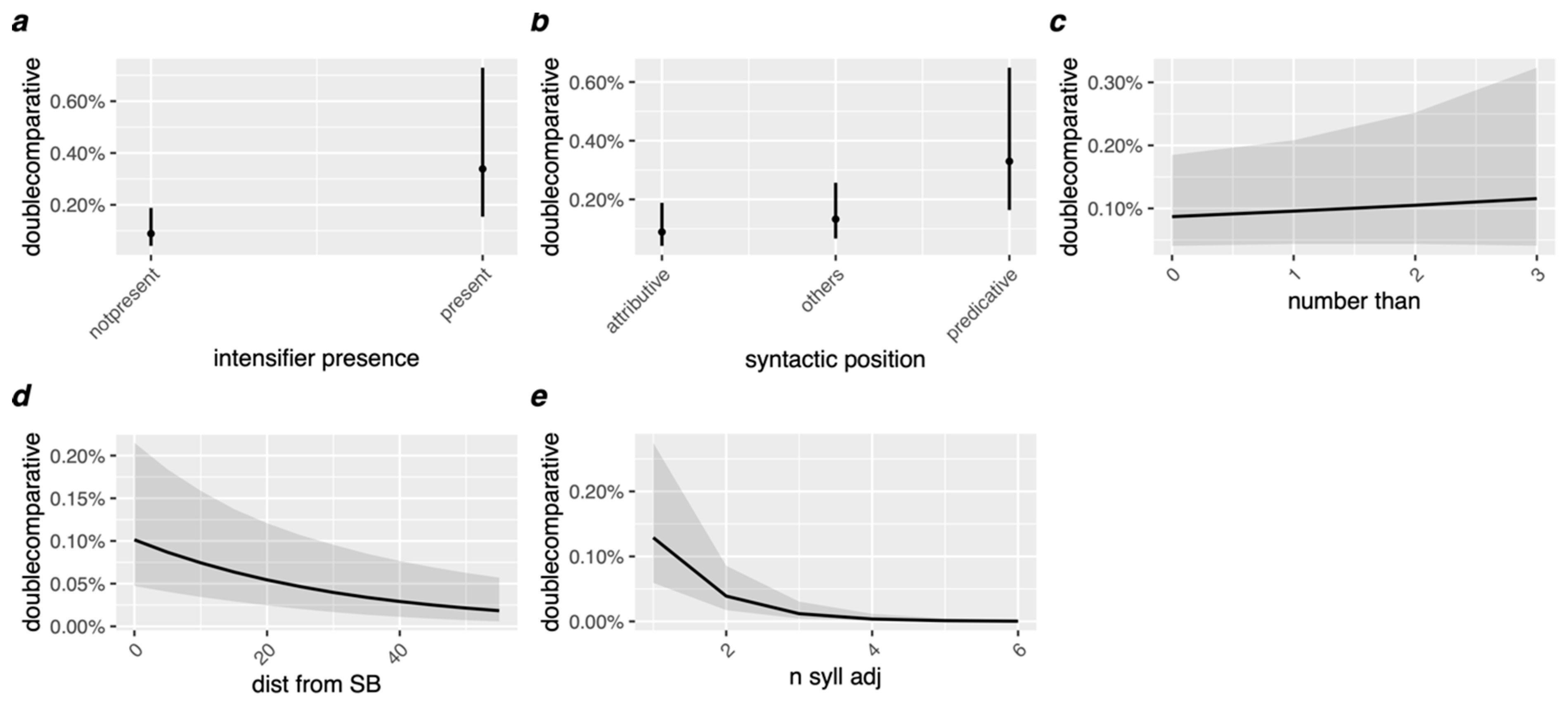
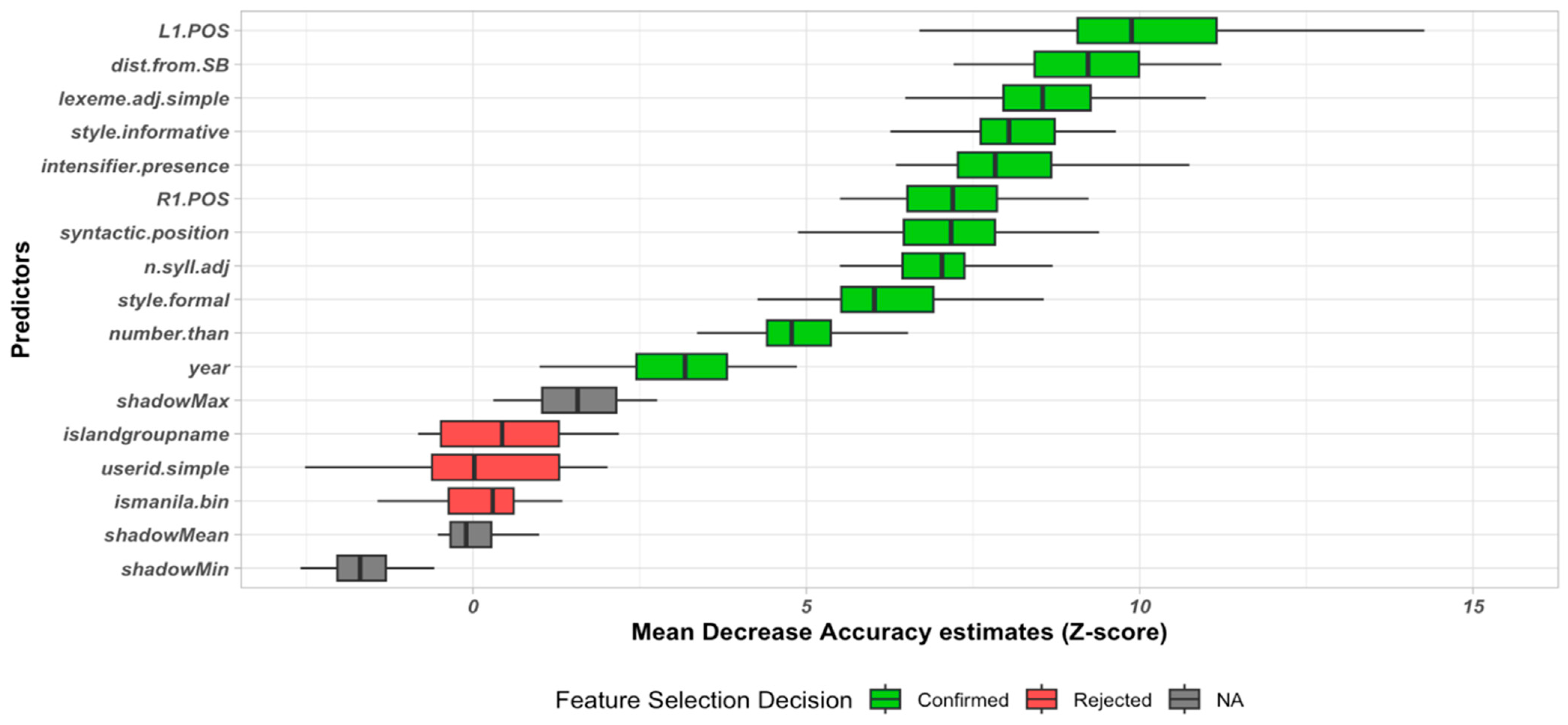
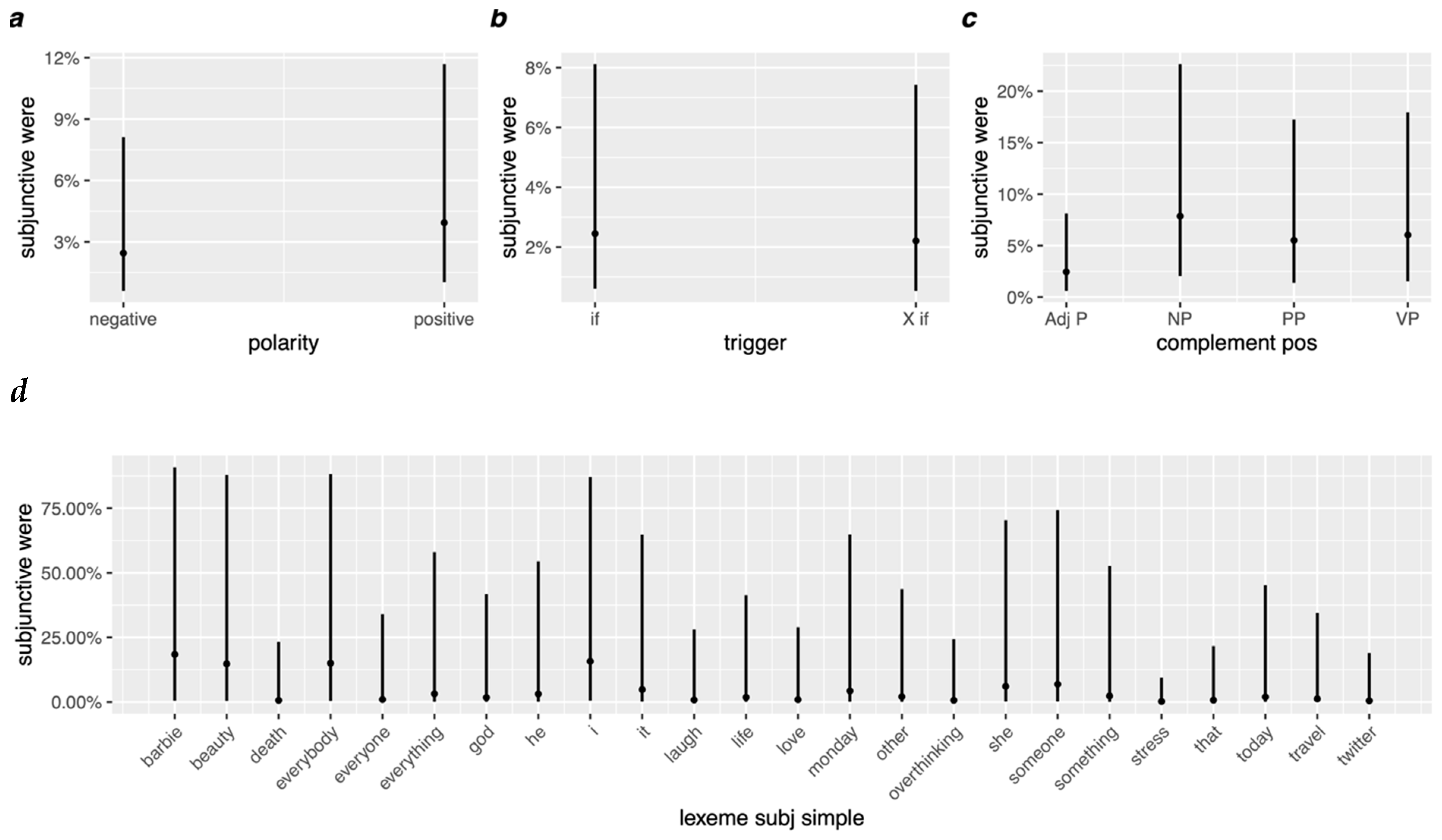

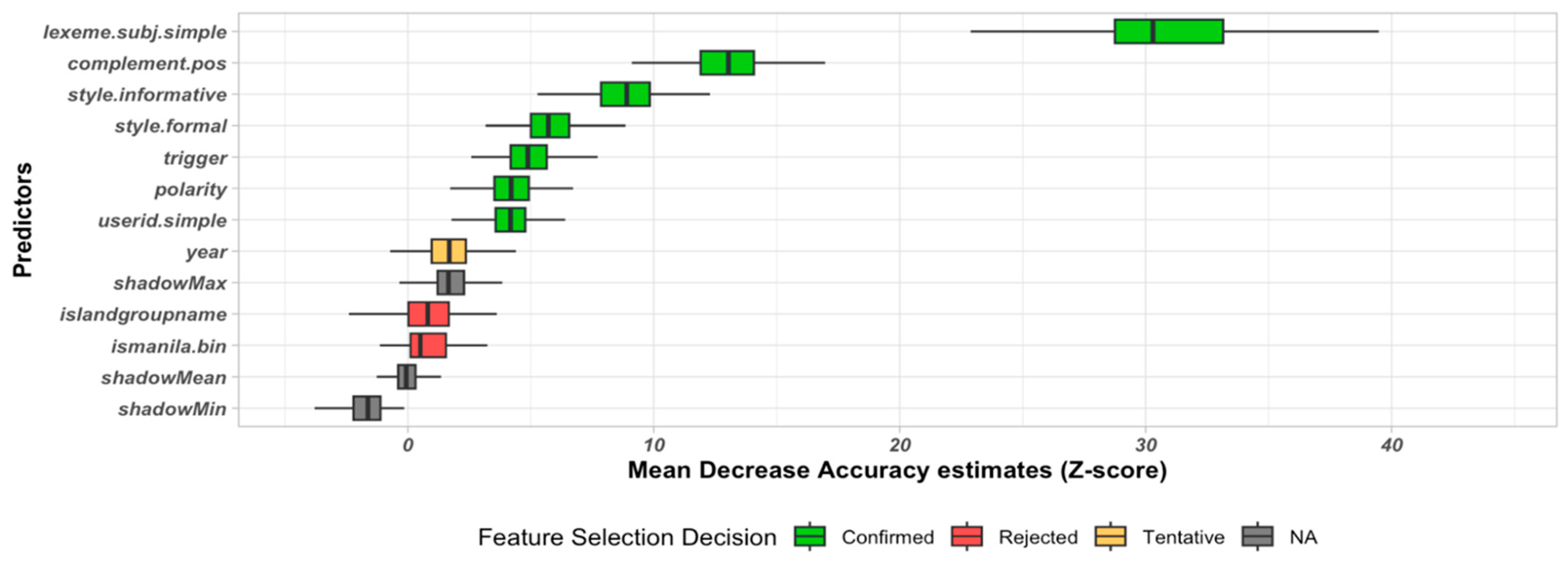
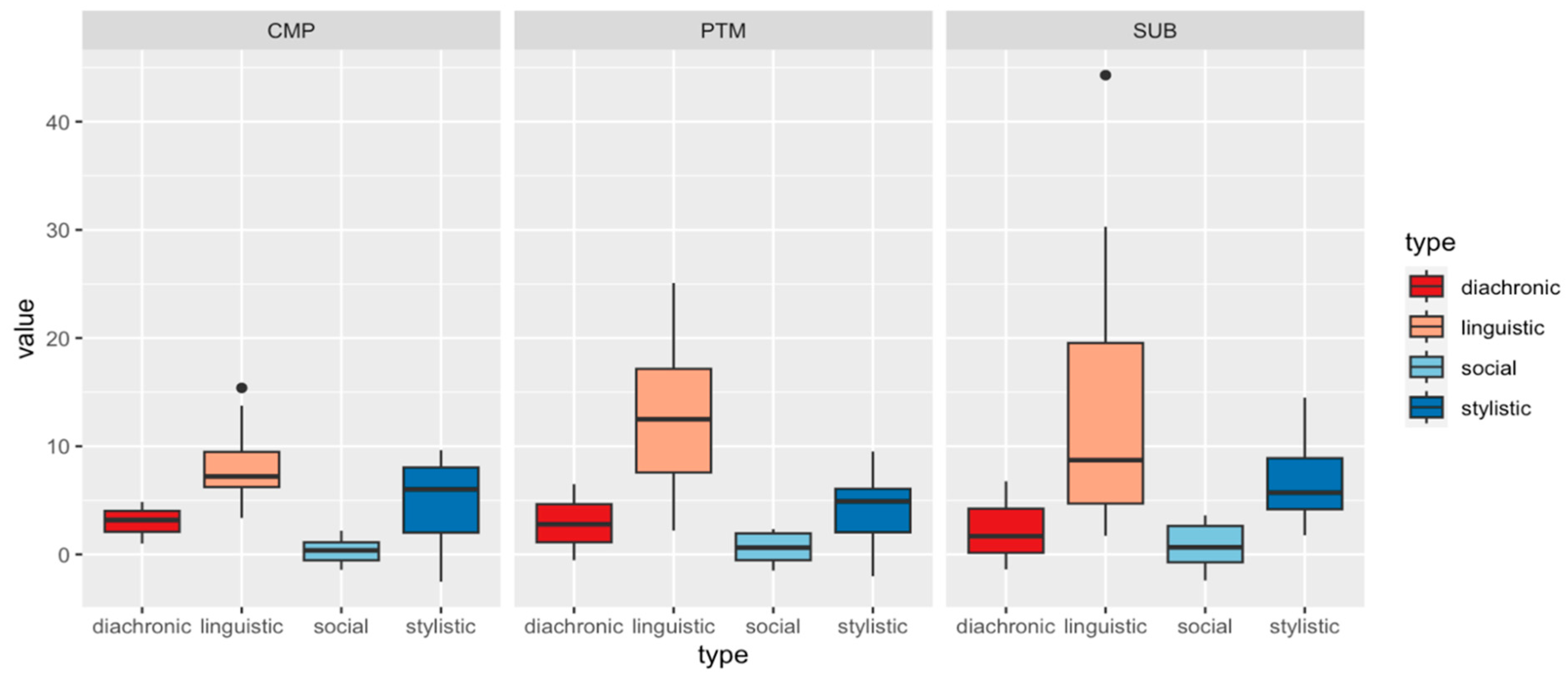
| Past Tense Morphology | Comparative Marking | Was/Were | |
|---|---|---|---|
| Linguistic |
|
|
|
| Social |
| ||
| Stylistic |
| ||
| Diachronic | Year | ||
| Lexeme | Raw | Normalized (z-Scoring by Corpus) | |||||
|---|---|---|---|---|---|---|---|
| NOW | GloWbE | ICE-PH | NOW | GloWbE | ICE-PH | Freq Index | |
| learn | 93,487 | 19,560 | 463 | 2.65 | 2.65 | 2.59 | 2.63 |
| burn | 11,093 | 2478 | 90 | −0.13 | −0.10 | 0.02 | −0.07 |
| dream | 8691 | 1961 | 103 | −0.21 | −0.18 | 0.11 | −0.09 |
| spell | 4054 | 900 | 40 | −0.37 | −0.35 | −0.32 | −0.35 |
| lean | 5467 | 813 | 24 | −0.32 | −0.37 | −0.43 | −0.37 |
| smell | 2897 | 870 | 30 | −0.41 | −0.36 | −0.39 | −0.39 |
| spill | 4306 | 406 | 12 | −0.36 | −0.43 | −0.51 | −0.44 |
| spoil | 3186 | 512 | 7 | −0.40 | −0.42 | −0.55 | −0.45 |
| leap | 1583 | 359 | 10 | −0.45 | −0.44 | −0.53 | −0.47 |
| a. Past tense morphology model (n = 3555 unobserved tokens)2 | |||
| Actual (Reference) | |||
| -ed | t | ||
| Predicted | -ed | 3056 | 141 |
| -t | 134 | 224 | |
| b. Comparatives model (n = 16,690 unobserved tokens)3 | |||
| Actual (Reference) | |||
| single | double | ||
| Predicted | single | 12,335 | 45 |
| double | 4165 | 145 | |
| c. Past subjunctive model (n = 872 unobserved tokens)4 | |||
| Actual (Reference) | |||
| was | were | ||
| Predicted | was | 384 | 95 |
| were | 161 | 232 | |
| Acc. (Bal. Acc.) | CI [Acc] | NIR | p [Acc > NIR] | ρ | CI [ρ] | t | p [ρ] | |
|---|---|---|---|---|---|---|---|---|
| Past tense morphology (n = 3555) | 0.92 (0.78) | 0.91–0.93 | 0.89 | <0.001 | 0.57 | 0.55–0.59 | 42.07 | <0.001 |
| Comparative (n = 16,690) | 0.74 (0.75) | 0.74–0.75 | 0.98 | 1 | 0.12 | 0.10–0.14 | 16.12 | <0.001 |
| Past subjunctive (n = 872) | 0.71 (0.70) | 0.67–0.74 | 0.63 | <0.001 | 0.40 | 0.35–0.46 | 12.98 | <0.001 |
| Parameter | Median | SD | 89% CI (HDI) | pd | ESS | |
|---|---|---|---|---|---|---|
| Fixed effects (population-level effects) | ||||||
| (Intercept) | −38.2 | 28.5 | −82.08–8.95 | 0.91 | 1 | 15,629 |
| Verbal form (preterite vs. participle) | 0.76 | 0.17 | 0.5–1.04 | 1 | 1 | 17,252 |
| Function (verbal vs. adjectival) | 4.47 | 0.2 | 4.16–4.79 | 1 | 1 | 17,577 |
| Voice (passive vs. active and adjectivals) | 0.44 | 0.24 | 0.04–0.82 | 0.96 | 1 | 15,409 |
| Frequency index | −0.04 | 1 | −1.64–1.53 | 0.51 | 1 | 13,217 |
| Island group (Mindanao vs. Luzon) | 0.11 | 0.12 | −0.08–0.3 | 0.82 | 1 | 15,951 |
| Island group (Visayas vs. Luzon and Mindanao) | 0.13 | 0.09 | −0.01–0.28 | 0.93 | 1 | 16,884 |
| City (Manila vs. non-Manila) | 0.02 | 0.13 | −0.18–0.23 | 0.57 | 1 | 16,869 |
| Style (informal—formal) | −0.02 | 0.03 | −0.07–0.03 | 0.75 | 1 | 16,571 |
| Style (interpersonal—informative) | −0.03 | 0.04 | −0.09–0.03 | 0.81 | 1 | 17,000 |
| Year | 0.02 | 0.01 | −0.01–0.04 | 0.89 | 1 | 15,638 |
| Random effects (group-level effects) | ||||||
| Lexeme—verb (intercept, SD) | 2.84 | 0.83 | 1.83–4.17 | 1 | 1 | 11,374 |
| User (intercept, SD) | 1.07 | 0.24 | 0.69–1.45 | 1 | 1 | 8855 |
| Type | Variable | Mean | Median | Min | Max | Norm Hits | Decision |
|---|---|---|---|---|---|---|---|
| Linguistic | Function (verbal vs. adjectival) | 19.63 | 19.50 | 15.68 | 24.10 | 1.00 | Confirmed |
| Linguistic | Lexeme—verb | 16.53 | 16.36 | 12.77 | 25.09 | 1.00 | Confirmed |
| Linguistic | Frequency index | 9.57 | 9.51 | 7.62 | 12.22 | 1.00 | Confirmed |
| Stylistic | Style (informal—formal) | 6.10 | 6.07 | 3.01 | 9.52 | 1.00 | Confirmed |
| Stylistic | Style (interpersonal—informative) | 5.52 | 5.52 | 2.05 | 8.56 | 1.00 | Confirmed |
| Linguistic | Voice (passive vs. active and adjectivals) | 4.31 | 4.20 | 2.20 | 7.45 | 0.98 | Confirmed |
| Diachronic | Year | 2.72 | 2.79 | −0.54 | 6.50 | 0.82 | Confirmed |
| Stylistic | User | 1.31 | 1.34 | −2.02 | 4.91 | 0.43 | Tentative |
| Social | Island group | 0.73 | 0.84 | −0.85 | 2.32 | 0.03 | Rejected |
| Social | City (Manila vs. non-Manila) | 0.40 | 0.43 | −1.50 | 2.35 | 0.02 | Rejected |
| Parameter | Median | SD | 89% CI (HDI) | pd | ESS | |
|---|---|---|---|---|---|---|
| Fixed effects (population-level effects) | ||||||
| (Intercept) | −44.52 | 28.51 | −87.76–3.33 | 0.94 | 1 | 15,628 |
| Presence of pre-modifying intensifier (present vs. not present) | 1.34 | 0.14 | 1.12–1.57 | 1 | 1 | 15,504 |
| Syntactic position (attributive vs. predicative) | 1.32 | 0.28 | 0.85–1.74 | 1 | 1 | 17,560 |
| Syntactic position (attributive/predicative vs. others) | −0.26 | 0.16 | −0.51–0.01 | 0.95 | 1 | 17,835 |
| Number of comparisons | 0.09 | 0.15 | −0.15–0.34 | 0.73 | 1 | 18,702 |
| Distance from sentence boundary | −0.03 | 0.01 | −0.05–−0.01 | 1 | 1 | 17,773 |
| Number of syllables (adjective) | −1.19 | 0.23 | −1.56–−0.83 | 1 | 1 | 11,316 |
| Island group (Mindanao vs. Luzon) | −0.21 | 0.11 | −0.38–−0.03 | 0.97 | 1 | 16,215 |
| Island group (Visayas vs. Luzon and Mindanao) | 0.1 | 0.08 | −0.03–0.23 | 0.87 | 1 | 15,412 |
| City (Manila vs. non-Manila) | −−0.14 | 0.13 | −0.35–0.06 | 0.86 | 1 | 16,522 |
| Style (informal—formal) | 0.14 | 0.03 | 0.09–0.19 | 1 | 1 | 16,617 |
| Style (interpersonal—informative) | 0.12 | 0.03 | 0.06–0.17 | 1 | 1 | 15,474 |
| Year | 0.02 | 0.01 | 0–0.04 | 0.92 | 1 | 15,646 |
| Random effects (group-level effects) | ||||||
| POS-L1 (intercept, SD) | 0.64 | 0.22 | 0.38–0.98 | 1 | 1 | 11,195 |
| Lexeme–adjective (intercept, SD) | 1.48 | 0.18 | 1.21–1.77 | 1 | 1 | 9458 |
| POS-R1 (intercept, SD) | 0.37 | 0.14 | 0.19–0.58 | 1 | 1 | 12,901 |
| User (intercept, SD) | 1.25 | 0.21 | 0.92–1.57 | 1 | 1 | 8535 |
| Type | Variable | Mean Imp | Median Imp | Min Imp | Max Imp | Norm Hits | Decision |
|---|---|---|---|---|---|---|---|
| Linguistic | POS-L1 | 10.24 | 9.88 | 6.69 | 15.39 | 1.00 | Confirmed |
| Linguistic | Distance from sentence boundary | 9.33 | 9.22 | 7.21 | 13.75 | 1.00 | Confirmed |
| Linguistic | Lexeme–adjective | 8.57 | 8.54 | 6.48 | 10.99 | 1.00 | Confirmed |
| Stylistic | Style (interpersonal—informative) | 8.10 | 8.04 | 6.26 | 9.64 | 1.00 | Confirmed |
| Linguistic | Presence of pre-modifying intensifier (present vs. not present) | 7.99 | 7.83 | 4.74 | 11.09 | 1.00 | Confirmed |
| Linguistic | POS-R1 | 7.22 | 7.20 | 5.50 | 9.23 | 1.00 | Confirmed |
| Linguistic | Number of syllables (adjective) | 7.04 | 7.03 | 5.50 | 9.72 | 1.00 | Confirmed |
| Linguistic | Syntactic position | 7.04 | 7.17 | 4.87 | 9.39 | 1.00 | Confirmed |
| Stylistic | Style (informal—formal) | 6.20 | 6.02 | 4.27 | 9.15 | 1.00 | Confirmed |
| Linguistic | Number of comparisons | 4.85 | 4.78 | 3.36 | 6.53 | 1.00 | Confirmed |
| Diachronic | Year | 3.05 | 3.18 | 1.00 | 4.86 | 0.81 | Confirmed |
| Social | Island Group | 0.47 | 0.44 | −0.82 | 2.19 | 0.00 | Rejected |
| Stylistic | User | 0.16 | 0.02 | −2.52 | 2.02 | 0.06 | Rejected |
| Social | City (Manila vs. non-Manila) | 0.07 | 0.30 | −1.43 | 1.34 | 0.00 | Rejected |
| Parameter | Median | SD | 89% CI (HDI) | pd | ESS | |
|---|---|---|---|---|---|---|
| Fixed effects (population-level effects) | ||||||
| (Intercept) | 21.46 | 28.58 | −24.32–67.03 | 0.77 | 1 | 24,511 |
| Polarity (negative vs. positive) | 0.48 | 0.27 | 0.05–0.91 | 0.97 | 1 | 25,628 |
| Trigger (if vs. X if) | −0.11 | 0.12 | −0.31–0.09 | 0.8 | 1 | 25,440 |
| Complement (NP vs. VP) | −0.29 | 0.09 | −0.44–−0.14 | 1 | 1 | 25,802 |
| Complement (PP vs. NP/VP) | −0.23 | 0.16 | −0.49–0.03 | 0.92 | 1 | 25,653 |
| Complement (AdjP vs. NP/VP/PP) | −1 | 0.15 | −1.23–−0.76 | 1 | 1 | 25,832 |
| Island group (Mindanao vs. Luzon) | −0.09 | 0.11 | −0.27–0.09 | 0.79 | 1 | 26,382 |
| Island group (Visayas vs. Luzon and Mindanao) | −0.24 | 0.09 | −0.38–−0.1 | 1 | 1 | 25,515 |
| City (Manila vs. non-Manila) | 0.09 | 0.13 | −0.11–0.29 | 0.76 | 1 | 25,917 |
| Style (informal—formal) | −0.01 | 0.03 | −0.07–0.03 | 0.68 | 1 | 24,493 |
| Style (interpersonal—informative) | 0.2 | 0.04 | 0.15–0.26 | 1 | 1 | 24,045 |
| Year | −0.01 | 0.01 | −0.03–0.01 | 0.8 | 1 | 24,467 |
| Random effects (group-level effects) | ||||||
| Lexeme—subject (intercept, SD) | 1.5 | 0.38 | 0.98–2.11 | 1 | 1 | 15,061 |
| User (intercept, SD) | 2.11 | 0.76 | 1.09–3.3 | 1 | 1 | 14,817 |
| Type | Variable | Mean Imp | Median Imp | Min Imp | Max Imp | Norm Hits | Decision |
|---|---|---|---|---|---|---|---|
| Linguistic | Lexeme—subject | 30.95 | 30.30 | 22.88 | 44.30 | 1.00 | Confirmed |
| Linguistic | Complement | 13.11 | 13.04 | 9.10 | 18.43 | 1.00 | Confirmed |
| Stylistic | Style (interpersonal—informative) | 8.98 | 8.90 | 5.27 | 14.50 | 1.00 | Confirmed |
| Stylistic | Style (informal—formal) | 5.86 | 5.71 | 3.16 | 9.25 | 1.00 | Confirmed |
| Linguistic | Trigger (if vs. X if) | 4.95 | 4.88 | 2.58 | 8.34 | 1.00 | Confirmed |
| Linguistic | Polarity (negative vs. positive) | 4.26 | 4.20 | 1.72 | 7.38 | 0.98 | Confirmed |
| Stylistic | User | 4.22 | 4.18 | 1.77 | 7.35 | 1.00 | Confirmed |
| Diachronic | Year | 1.72 | 1.69 | −1.39 | 6.77 | 0.55 | Tentative |
| Social | Island group | 0.79 | 0.81 | −2.40 | 3.62 | 0.08 | Rejected |
| Social | City (Manila vs. non-Manila) | 0.76 | 0.51 | −1.14 | 3.24 | 0.03 | Rejected |
Disclaimer/Publisher’s Note: The statements, opinions and data contained in all publications are solely those of the individual author(s) and contributor(s) and not of MDPI and/or the editor(s). MDPI and/or the editor(s) disclaim responsibility for any injury to people or property resulting from any ideas, methods, instructions or products referred to in the content. |
© 2024 by the author. Licensee MDPI, Basel, Switzerland. This article is an open access article distributed under the terms and conditions of the Creative Commons Attribution (CC BY) license (https://creativecommons.org/licenses/by/4.0/).
Share and Cite
Gonzales, W.D.W. The Holistic Advantage: Unified Quantitative Modeling for Less-Biased, In-Depth Insights into (Socio)Linguistic Variation. Languages 2024, 9, 182. https://doi.org/10.3390/languages9050182
Gonzales WDW. The Holistic Advantage: Unified Quantitative Modeling for Less-Biased, In-Depth Insights into (Socio)Linguistic Variation. Languages. 2024; 9(5):182. https://doi.org/10.3390/languages9050182
Chicago/Turabian StyleGonzales, Wilkinson Daniel Wong. 2024. "The Holistic Advantage: Unified Quantitative Modeling for Less-Biased, In-Depth Insights into (Socio)Linguistic Variation" Languages 9, no. 5: 182. https://doi.org/10.3390/languages9050182
APA StyleGonzales, W. D. W. (2024). The Holistic Advantage: Unified Quantitative Modeling for Less-Biased, In-Depth Insights into (Socio)Linguistic Variation. Languages, 9(5), 182. https://doi.org/10.3390/languages9050182





